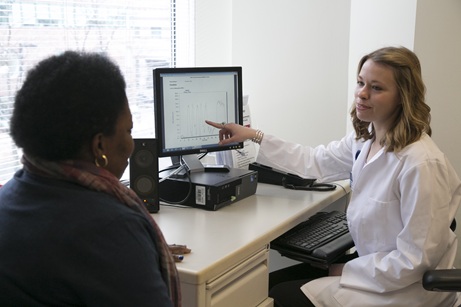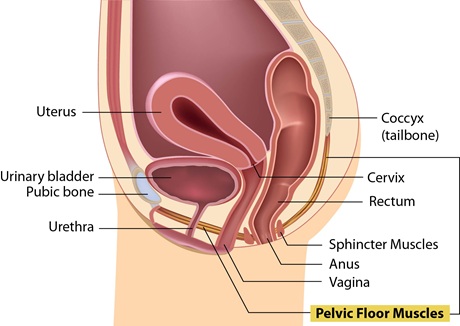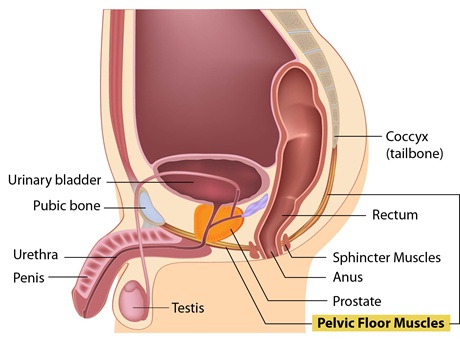Treating Pelvic Floor Conditions with Therapy
 If you struggle with tight or weak pelvic floor muscles and are dealing with urinary or bowel frequency, urinary or fecal incontinence, pain or prolapse, physical therapy can provide great relief or even resolution.
If you struggle with tight or weak pelvic floor muscles and are dealing with urinary or bowel frequency, urinary or fecal incontinence, pain or prolapse, physical therapy can provide great relief or even resolution.
These pelvic floor muscles help in holding your bladder and uterus (women), and prostate (men) and rectum in place. The contractions and relaxation of the muscles also help control your urine flow, bowel movements, and sexual functioning.
Causes of Pelvic Floor Disorders
- Obesity
- Heavy lifting
- Repeated straining (such as during a bowel movement or with a chronic cough)
- Surgery
- Radiation
- Genetics
In Women
- Pregnancy-related changes in the body
- Straining during childbirth
- Damage to the pelvic floor during childbirth
- Decreased estrogen levels during menopause
Physical Therapy Treatment
During your first visit, you and your physical therapist will discuss your health history, concerns and current symptoms. An internal exam may be conducted to assess your pelvic floor muscles and help determine causes. After a thorough evaluation, the physical therapist will develop a personalized treatment plan that will include a detailed explanation and demonstration of exercises to do at home. Your physical therapist may
recommend additional specialists and will work closely with your physicians to keep them updated on your progress.
Therapies
- Pelvic floor muscle training
- Abdominal and core strengthening
- Instructions on how to stand, sit or move with less stress on the pelvic floor
- Bladder training
- Dietary modifications
- Heat and cold therapy
- Techniques performed manually by the therapist to stretch soft tissue
- Using sensors to monitor your muscle activity on a computer
- Electrical stimulation, which can help muscles contract more strongly.
Download our patient information packet, All About Pelvic Floor Physical Therapy, and related handouts for further information:
Frequently Asked Questions
What is the Pelvic Floor?
The pelvic floor is made up of muscles and other tissues that form a "supportive sling" or "hammock" from the pubic bone to the tailbone (coccyx). These muscles assist in holding your bladder, uterus (women), prostate (men), and rectum in place. The contractions and relaxation of the muscles also help you control your urine flow, bowel movements, and sexual functioning. Problems with these muscles may result in urinary or bowel incontinence and/or pelvic pain.
What is Pelvic Floor Physical Therapy?
Pelvic floor physical therapy is a type of therapy that focuses on the muscles of the pelvic floor. Our physical therapists are musculoskeletal experts trained specifically in the evaluation and treatment of the pelvic floor muscles. We use a combination of “hands-on” therapy to teach patients how to properly use their pelvic floor muscles. Pelvic floor physical therapy can provide highly effective treatment and relief of pelvic floor dysfunction symptoms.
What is Pelvic Floor Dysfunction?
Pelvic floor dysfunction is a term used to describe a problem with the muscles that support the pelvic floor. Tight or weak pelvic floor muscles may result in symptoms such as changes in urinary or bowel frequency, urinary or fecal incontinence, or pain. Pelvic floor dysfunction affects both women and men.
Some patients experience more than one symptom at the same time. Our team works together to coordinate care and evaluate, treat and communicate complex pelvic floor disorders.
What Causes Pelvic Floor Dysfunction?
There are many factors that may contribute to the condition, including traumatic injuries to the pelvic area (such as an accident), obesity, heaving lifting, repeated straining (such as during a bowel movement or with a chronic cough), surgery, radiation, and genetics. In women, pregnancy-related changes in the body, straining during childbirth, damage to the pelvic floor during childbirth, as well as decreased estrogen levels during menopause can also lead to a weakening of the pelvic floor muscles.
Treatment
There are many diverse treatment options available to our patients. Depending on your diagnosis, more than one treatment option may be recommended. Please carefully read the information provided to you at your appointment with your physical therapist and contact us with any questions.
Treatment options include:
- Pelvic floor muscle training
- Abdominal and core strengthening
- Postural awareness and education on body mechanics with daily activities
- Bladder training
- Dietary modifications
- Heat and cold therapy
- External and internal soft tissue mobilization
- Biofeedback
- Electrical stimulation
Your First Visit
During your first visit, you and your physical therapist will discuss your health history, concerns and current symptoms related to the pelvic floor. An internal exam may be conducted to further assess your pelvic floor
muscles and help determine what is causing the symptoms.
After the thorough evaluation, you and your physical therapist will develop a personalized treatment plan that will include a detailed explanation and demonstration of exercises to do at home. You will receive All About Pelvic Floor Physical Therapy, our patient information packet, along with specific information related to your condition. Your physical therapist may recommend additional specialists, and will communicate with other members of your medical team and help coordinate care. This visit may take approximately an hour. 
Follow-up Treatment/Care
Your physical therapist will give you exercises to do at home. Make sure you follow the at-home treatment recommended, and if you have any questions, please call 617-754-9100.
Please read the additional specific information your specialist provides to you during your appointment. This information further explains your condition as well as your personalized treatment plan.
 If you struggle with tight or weak pelvic floor muscles and are dealing with urinary or bowel frequency, urinary or fecal incontinence, pain or prolapse, physical therapy can provide great relief or even resolution.
If you struggle with tight or weak pelvic floor muscles and are dealing with urinary or bowel frequency, urinary or fecal incontinence, pain or prolapse, physical therapy can provide great relief or even resolution.


